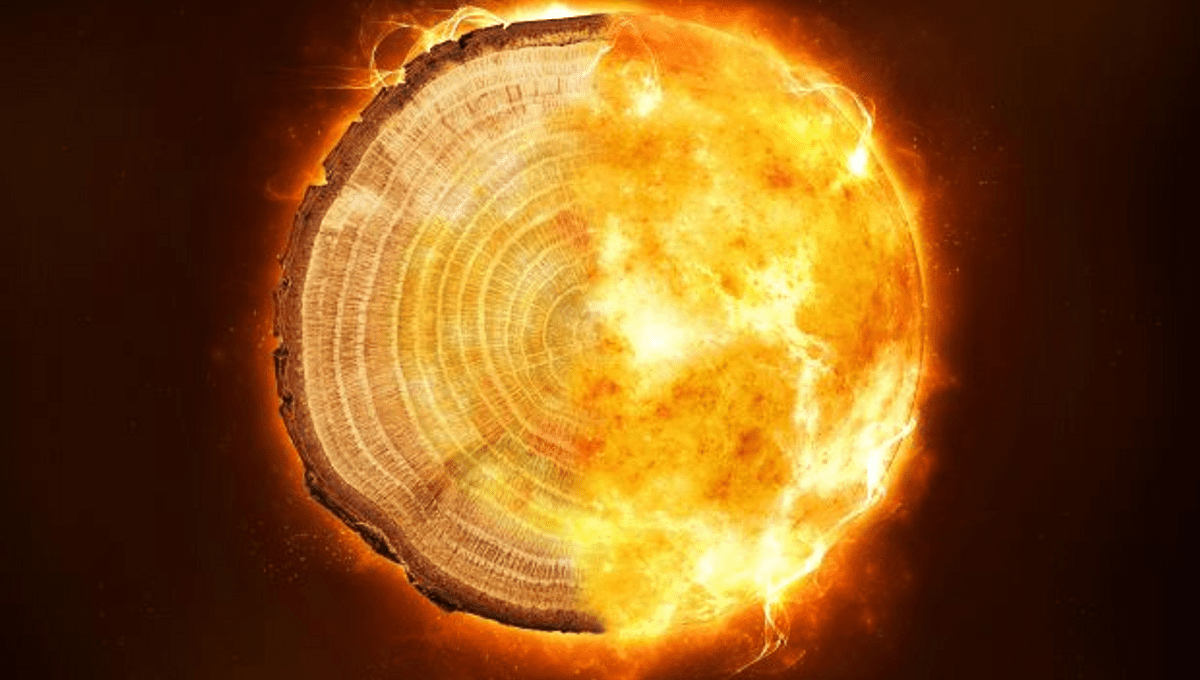
Once every thousand years or so carbon-14 production high in the atmosphere surges spectacularly creating potentially devastating radiation storms. Astronomers have theories about what could cause this, but the most comprehensive study of these events yet appears to rule all the likely ones out, leaving the cause more mysterious than ever.
High energy particles hitting nitrogen atoms in the upper atmosphere produce radioactive carbon-14 – the longest-lived radioactive isotope of carbon – which enters the planetary carbon cycle and becomes incorporated in plants. This means ancient tree rings can reveal the annual history of carbon-14 abundance going back thousands of years.
Explanations have been found for the modest variations in carbon-14 abundance seen over the last thousand years, but an immense spike in 774 CE was instantly puzzling when discovered a decade ago. However, a new study collaboration between scientists of many fields has been stumped trying to identify the cause of this and similar events.
The 774 carbon-14 spike was identified in Japanese tree rings by a team led by physicist Fusa Miyake of Nagoya University in 2012. It has since been confirmed as a global phenomenon, named in Miyake’s honor. Similarly-sized global events have been confirmed in 993 CE and 660, 5259, 5410, and 7176 BCE. Several smaller events have also been identified, while others remain debated, with conflicting data from different locations. Inevitably, the further back in time you go, the harder it is to find accurately dated tree rings to conform or refute such events.
Dr Benjamin Pope of the University of Queensland describes the new study as the most comprehensive investigation of Miyake events yet conducted. However, he acknowledged to IFLScience that it has deepened the mystery of their cause, rather than explaining it.
The first guess about Miyake events was that they were caused by enormous solar flares on a scale perhaps ten times the Carrington Event of 1859. This would be a very frightening prospect. If the Carrington Event occurred today it would wipe out a large portion of our satellites, Internet cables, and electricity transmission lines, throwing society into chaos. Something an order of magnitude larger is hard to imagine.
However, if this is the case, we would expect Miyake events to coincide with solar cycle peaks. Pope and co-authors couldn’t find any evidence of that. An alternative explanation is actually the opposite. Solar activity boosts the solar wind and helps shield the Earth from cosmic rays. Miyake events therefore could represent brief but extreme solar minima, condensed versions of the Maunder Minimum, when sunspots and solar flares vanished.
Pope told IFLScience this remains a possibility, but his team couldn’t find evidence to confirm it.
Alternatively, Miyake events might have nothing to do with the Sun, instead being triggered by supernovas or other cosmic events. Yet no Miyake event coincided with any of the known supernovas of the last millennium, seemingly a death blow to that idea. The paper raises the possibility they are caused by nearby magnetars but acknowledges we haven’t found one close enough to Earth to be a plausible culprit.
Although the authors can’t explain these events, they did learn something important. At least one Miyake event lasted more than a year, and others may also have been extended.
“Rather than a single instantaneous explosion or flare, what we may be looking at is a kind of astrophysical ‘storm’ or outburst,” first author and undergraduate student Qinyuan Zhang said in a statement.
Pope told IFLScience that’s probably good news. “More spread out and less catastrophic is good for us, although it still could create problems over a prolonged period.” For Pope, this emphasizes the need to understand events that have an almost 1 percent chance of occurring in the next decade.
A pre-electrical world would not have been affected by extreme space weather the way we would today, but we might hope someone noticed. Pope told IFLScience that the only ambiguous report that might relate to what was happening at the time is a reference in the Anglo-Saxon Chronicle to a “red crucifix after sunset” in 774 CE. This is the only astronomical event described in the Chronicle. It is generally thought to refer to an aurora, but as Pope told IFLScience, “To a medieval monk, everything looked like a crucifix,” limiting its modern usefulness.
The paper is published in Proceedings of the Royal Society A.
Source Link: Ancient Tree Rings Shed Light On Mysterious Miyake Events – Huge Cosmic Radiation “Storms”